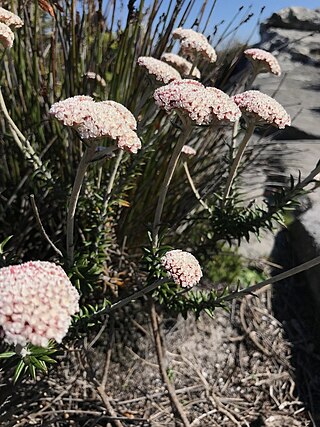Persoonia spathulata is a species of flowering plant in the family Proteaceae and is endemic to the south-west of Western Australia. It is an erect to spreading shrub with hairy young branchlets, spatula-shaped leaves, and yellow flowers arranged singly or in pairs on a rachis up to 2 mm (0.079 in) long that continues to grow after flowering.
Vlokia ater was the first species described for the genus Vlokia in the Aizoaceae plant family. The genus name honors the discoverer, South African botanist, Jan H. J. Vlok (1957-). The species name derives from the Latin adjective "ater" for "black" and refers to the black coloring which older leaf leaves assume.

Felicia dregei is an evergreen, glandular shrub of up to 11⁄2 m (5 ft) high, that is assigned to the family Asteraceae. It has flat, finely felty, grayish green, narrowly elliptic to lance-shaped leaves of up to 4 cm long and 8 mm wide, with an entire margin or here and there with up to ten teeth. The flower heads have about ten violet ray florets, encircling many yellow disc florets. This species grows in the Northern Cape and Western Cape provinces of South Africa.

Felicia nordenstamii is a flowering shrub in the family Asteraceae. It is found only in South Africa where it grows on limestone hills close to the sea on the southern coast. Felicia nordenstamii is a many-branched shrub growing up to 30 cm (1 ft) tall. The lower parts of the stems are covered in grayish brown bark and the upper stem has many crowded, upwardly angled, alternate leaves with long hairs on the lower surfaces. Large flower heads form at the tips of the branches, each about 41⁄2 cm across, with about thirty purplish blue ray florets surrounding many yellow disc florets.

Mairia coriacea is a perennial plant assigned to the family Asteraceae. It has broad, tough and leathery, evergreen leaves. These have a narrowed foot and an entire margin or a few shallow, irregular teeth. They grow in a rosette directly from the rootstock. The plant produces flower heads with one whorl of white to mauve ray florets around many yellow disc florets, with one or few on top of a dark reddish, woolly stalk. Flower heads appear after the overhead vegetation burnt down, often destroying the leaves in the process. It can be found in the southern mountains of South Africa's Western Cape province. It is called leather leaves in English.

Mairia burchellii is a tufted perennial plant of up to 15 cm (6 in) assigned to the family Asteraceae. It has narrow leaves of up to 5 mm (0.20 in) wide, with single main vein and an entire margin. Flower heads only occur after a fire has destroyed the standing vegetation, mostly in November or between February and June. The flower heads sit individually or with a few on the tip of a purplish stalk, with a few narrow bracts, and consist of a row of pinkish ray florets around many yellow disc florets. It can be found in the southwest of the Western Cape province of South Africa.

Felicia mossamedensis or yellow felicia is a well-branched, roughly hairy, annual or perennial plant of up to 30 cm (1 ft) high, assigned to the family Asteraceae. It has alternately arranged, seated, flat to slightly succulent, broad-based, entire, blunt tipped leaves. The flower heads sit individually on top of a stalk of up to 8 cm (3 in) long, have an involucre of three whorls of bracts, many yellow ray florets and many yellow disk florets. It can be found in southern Africa, in Zimbabwe, Mozambique, Botswana, Eswatini, South Africa and on the coast of Angola.

Trichodiadema mirabile is succulent plant of the genus Trichodiadema, native to the Western Cape Province, South Africa, where it is known from the Laingsburg area and especially from south-facing slopes.
Acrodon deminutus, also known as the Malgas tiptoothfig, is a species of mesemb from South Africa.
Acrodon caespitosus, the Potberg tiptoothfig, is a species of mesemb from South Africa.
Acrodon parvifolius, the Botriver tiptoothfig, is a species of mesemb from South Africa. This species, which grows close to the ground, can best be recognised by its small, thin leaves and its flowers, which form a dome in the middle.

Cheiridopsis speciosa is a species of plant from South Africa.
Cheiridopsis schlechteri is a species of plant from South Africa. It is a succulent plant that grows in dry habitats.
Cheiridopsis turbinata is a succulent plant from South Africa.
Cheiridopsis umbrosa is a succulent plant from South Africa.
Cheiridopsis purpurea is a species of succulent plant from South Africa. It is found growing in the succulent Karoo vegetation type.
Cheiridopsis umdausensis is a species of succulent plant from South Africa.
Cheiridopsis pilosula is a species of succulent plant from Namaqualand in the Northern Cape of South Africa.
Cheiridopsis ponderosa is a species of succulent plant from South Africa.

Anaxeton arborescens, the northern paperposy, is a species of plant from South Africa. It grows in the fynbos biome.







